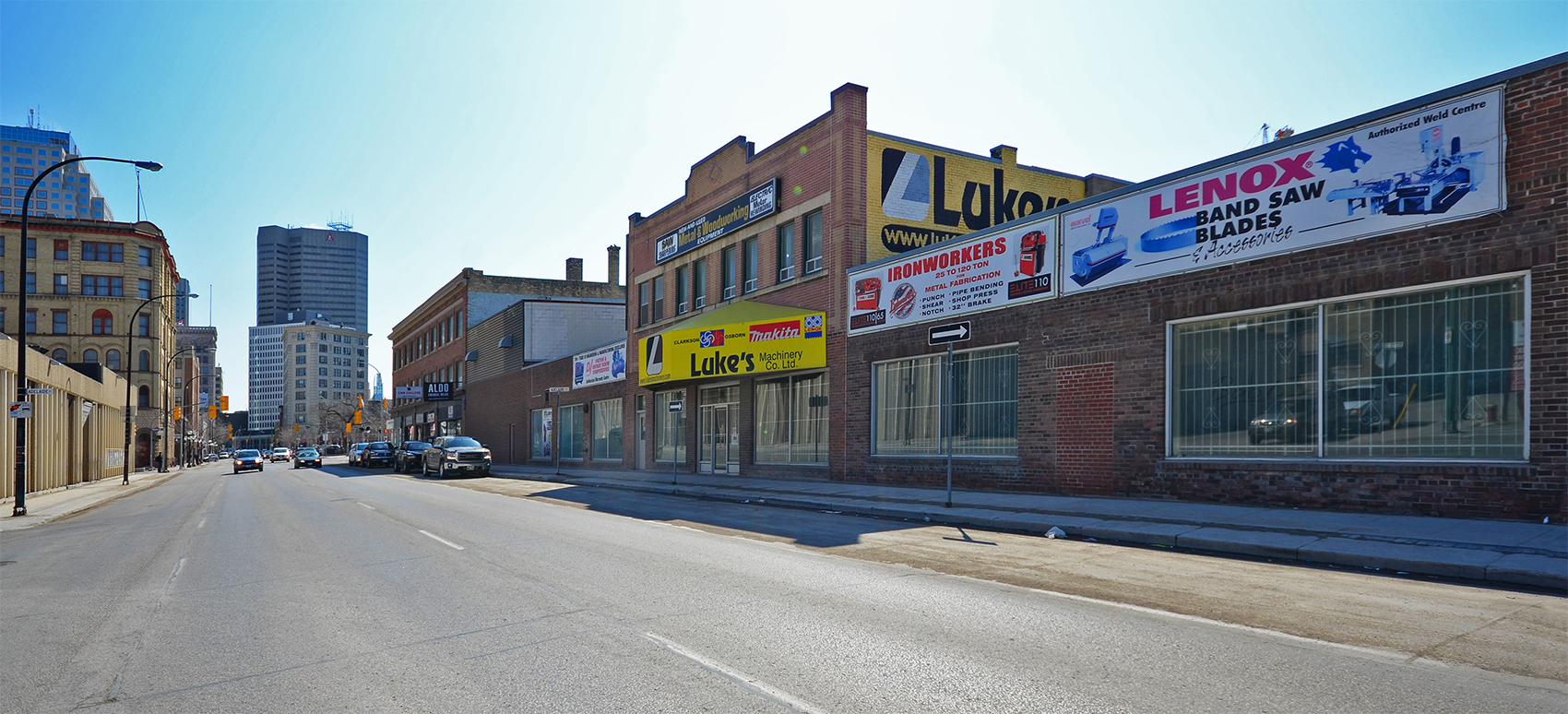By Brent Bellamy, Creative Director and Architect


IN the past decade, downtown has experienced development and renewal. To keep up with increasing electrical demand and serve this growth, Manitoba Hydro will soon begin construction on a new $62-million substation downtown.
It will be located on a large parking lot at the corner of Adelaide Street and Notre Dame Avenue, previously owned by nearby Calvary Temple. As part of the transaction to secure the property, Hydro agreed to replace the church parking by co-ordinating the purchase of an adjacent 40-stall lot with the intent of demolishing four commercial buildings along Notre Dame to make room for another 35 cars. An application to the city for a demolition permit has not yet been submitted, but intentions to do so have been made public.
An important obstacle facing this scheme is that demolition to create surface parking as a primary use on a downtown property is no longer permitted. Building demolition is only allowed with proof that an appropriate redevelopment plan is forthcoming.
The negative effect surface parking lots have on urban areas is well recognized across North America, and these restrictions in Winnipeg have been put in place to begin the long process of reversing their blight on our city. It is staggering to consider that almost one-quarter of Winnipeg's downtown is devoted to surface parking.
The most significant reason they are so detrimental to urban areas is that they degrade the pedestrian experience, which has a cascading effect on the economic and physical health of the city. Unlike suburban businesses that cater to the automobile, commerce downtown relies on a volume of foot traffic for its success. Large swaths of asphalt parking reduce the density of a neighbourhood and in turn the intensity of that pedestrian traffic, hurting the economic vitality of the area.
Buildings constructed to the sidewalk improve the pedestrian experience by creating a continuous edge that provides shelter, increased retail density and activity, greater visual interest and connection to interior spaces. This edge encloses the peripheral expanse of a street, which intuitively slows vehicular traffic, heightening pedestrian comfort and security.
Surface parking also increases the perception of crime in a downtown. Building density and increased sidewalk traffic is a self-policing deterrent to criminal activity. Crime is attracted to secluded open spaces such as parking lots, and without feeling connected to adjacent buildings as a pedestrian, the perception of safety decreases as one's feeling of isolation increases.
Every Winnipeg mayor since Glen Murray has recognized the negative effect of surface parking on downtown and each has campaigned on promises to reduce their numbers. Former mayor Sam Katz referred to them as "magnets for crime" and Mayor Brian Bowman along with Premier Selinger, who himself made anti-parking-lot pledges, recently announced an important new residential grant program that targets development on open lots. For initiatives such as this to be successful long-term, it's crucial we maintain consistent values and uphold these goals and ideals in all instances.
The demolition application for the Notre Dame properties will likely make the argument the overall amount of surface parking will not increase because the substation will rise on a lot across the street. This may be technically true, but if impact on the neighbourhood is the measure of a project's value, the parking-lot trade is not an even one. A building is not merely the inverse of a parking lot. The opportunity it provides and its interaction with the street are what create relative value for the neighbourhood.
Many people will look at these four buildings and decide they are small, old and of no real worth, but these types of buildings are vital for establishing healthy and economically prosperous urban neighbourhoods.
The high rents required to make new construction viable in Winnipeg generally prevent local or small business from affording space in new buildings. Redevelopment of older structures such as these can provide lower-cost opportunities for small-scale commerce, promoting a diversity and entrepreneurship that is the backbone of a neighbourhood's economy.
The West End has seen a renaissance, transforming itself into one of the most vibrant and diverse neighbourhoods in the city, fuelled by a proliferation of small, unique, family-owned businesses that have found success in the low-cost model offered by the older buildings in the area.
Located on a busy thoroughfare between Central Park and the West End, the Notre Dame buildings are perfectly situated to provide opportunity for the area's population, many of whom are new immigrants or migrants from rural areas searching for an independent livelihood. The restaurants, corner stores, retail shops and services that build a strong, vibrant community can only find a home in these types of small, older structures. With three unique storefronts, low commercial rents and small flexible spaces, the Notre Dame buildings can be a catalyst in furthering the neighbourhood's transformation by enabling this fine-grain commercial growth.
Startup companies, arts groups and non-profit incubator organizations have also found success in these types of buildings. Winnipeg's new Innovation Alley, directly adjacent to the Notre Dame properties is a celebrated collection of creative industries that could only have happened in the low-rent spaces of older buildings.
Manitoba Hydro is making a significant contribution to downtown Winnipeg by constructing its new substation. Calvary Temple has been an important and positive presence in the city centre for several decades. There is a strong will from both partners to be good neighbours and to do what is best for the community. The Central Park and West End neighbourhoods deserve more than a parking-lot trade and the status quo. They deserve a project that improves the safety, economic opportunity and sense of pride for everyone who lives in those communities.
If a provincial Crown corporation is allowed to co-ordinate the creation of a new surface parking lot on one of downtown's main commercial streets, the precedent will be difficult to defend when private building owners hope to follow suit and cash in on the reduced property taxes, low maintenance costs and easy profits surface parking can provide.
Reducing the four unassuming buildings on Notre Dame to rubble would represent a lost opportunity to make positive change in a sensitive inner-city neighbourhood. It is not too late to reconsider the need for those 35 parking stalls and find a solution that is a win for Manitoba Hydro, for Calvary Temple and for everyone in the community.
Brent Bellamy is senior design architect for Number Ten Architectural Group.
Republished from the Winnipeg Free Press print edition April 13, 2015 B3

